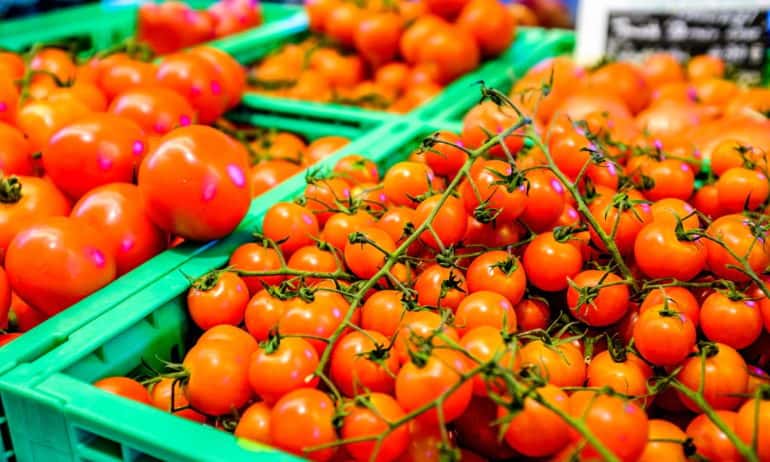In Nigeria, one promising tactic for getting nutrient-dense fresh fruits and vegetables to communities with high rates of malnutrition starts with a simple swap: trading traditional raffia baskets for plastic crates when transporting tomatoes from farm to market.
“These perishable foods, you’ve got to move them, and they’ve got to get to market fast, and they’ve got to be safe,” says Bonnie McClafferty, the food value chain director at the Global Alliance for Improved Nutrition (GAIN). “Everybody wants to look at staples. Staples are easy, you can put them in a silo. But because these foods are so tender, you need to look at an entirely different infrastructure that has to be well-timed, well-honed, and well-managed.”
Improving that infrastructure to make sure more fresh, healthy food actually reaches the people who need it is the focus of the Postharvest Loss Alliance for Nutrition (PLAN), one of GAIN’s supply chain intervention programs.
While many organizations have been tackling the global food waste problem in various innovative ways, PLAN takes a unique approach by drawing a clear line between food loss and nutrition loss, and by implementing solutions that reduce the waste that happens between the farm gate and the consumer.
How the PLAN works
PLAN is a global platform, and GAIN engages governments and private sector businesses around the world in conversations about how postharvest loss affects nutrition. “We collect global standards, we help design other projects, and we have global dialogues around the topic,” McClafferty explains, “but I think its big strength and the emphasis is in-country.”
In individual countries, GAIN connects with local governments and businesses to identify commodities that have a high rate of postharvest loss and that, if access were increased, could potentially improve nutrition outcomes for the population.
It then works with businesses to figure out what’s causing the waste in the supply chain and how to address the problem via infrastructure improvements to things like refrigeration, transportation logistics, and the location of processing facilities.
One major strength is that since PLAN is a global partnership, McClafferty says the organization can draw on the expertise of companies that have already perfected supply chain operations elsewhere. In the US, for example, “It took us years to get Salinas Valley Romaine to the East Coast so you didn’t lose it within three or four days,” she says. “So the idea is to help bring these innovations and knowledge over so that we don’t have to go through this incredibly painful transformation in the food system that takes a long time.”
PLAN is just getting off the ground in Ethiopia. In Indonesia, a commodity has been identified, and businesses are now submitting ideas for ways to improve the postharvest transportation of fresh fish to local consumers. In Nigeria, however, PLAN has been up and running for almost two years and is already having a major impact.
Tomato Transport
According to Unicef, six million Nigerian children (almost 40 percent of the children in the country) were stunted (which is defined as chronically malnourished or low height for age), more than half of them severely, in 2015. 30 percent of children under age five are also deficient in vitamin A, a condition that is the leading cause of preventable childhood blindness in the world.
The tomato emerges as a plump hero. In addition to many other important vitamins like C and K and minerals like potassium, it’s a great source of vitamin A. One medium whole tomato provides about 20 percent of the recommended daily value.
PLAN senior project manager Augustine Okoruwa explains that tomatoes are also ubiquitous in Nigeria. Of the vegetables consumed at home in the country, he said tomatoes make up anywhere from 50 to 80 percent. Nigerian farmers also produce a lot of tomatoes and most are eaten fresh as opposed to being destined for processing.
The problem was that of the 1.8 million metric tons of tomatoes being grown by farmers in the North, only about 50 percent were making it to the big markets, like Lagos, in the South. “GAIN did an analysis and identified the key postharvest issues and identified the tomato as one of those crops that had the highest post-harvest loss,” Okoruwa said. “When we did the supply chain mapping, it was very clear that there were key points where huge losses take place.”
First up: the crates. Farmers were transporting tomatoes long distances on bumpy roads and as they were jostled within the raffia baskets they were packed in, many were destroyed. PLAN identified the fact that plastic crates would protect the tomatoes much more efficiently and then promoted the use of the crates to 17 markets. PLAN members then purchased over 80,000 plastic crates, each of which holds an average of 20kg of fresh tomatoes.
The other major intervention was improving the cold chain by funding cold storage facilities and refrigerated trucks, so fewer tomatoes would spoil before reaching markets. Okoruwa said PLAN’s work in Nigeria increased the amount of produce going into cold storage from six tons to 100 tons. “That implies that this produce will not be wasted, that it will instead get to consumers in the best state,” he said. And earlier this year when they measured the postharvest loss rate of some of the companies that had made improvements via new crates and cold storage, he said, they found the producers had reduced their loss rate to around five percent.
Now, PLAN Nigeria is supporting local businesses to create a Cold Chain Association that will support the growth of Nigeria’s Cold Chain sector. It has also held 20 workshops to train 850 individuals on topics like food safety, crating, and cold chain coordination. That development points to an important fact: it’s not just about tomatoes.
“The interventions themselves are what I call horizontal,” McClafferty says. “So if we’ve improved warehousing for tomatoes, you can then substitute multiple nutritious foods in. So it’s got a much bigger impact.”










